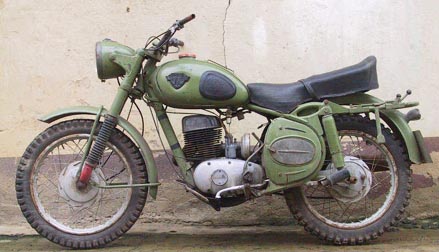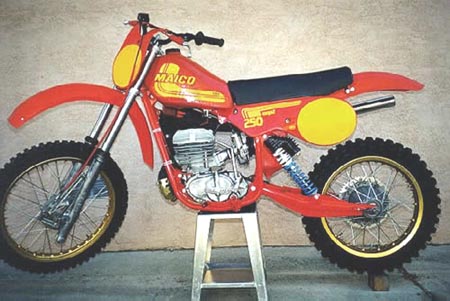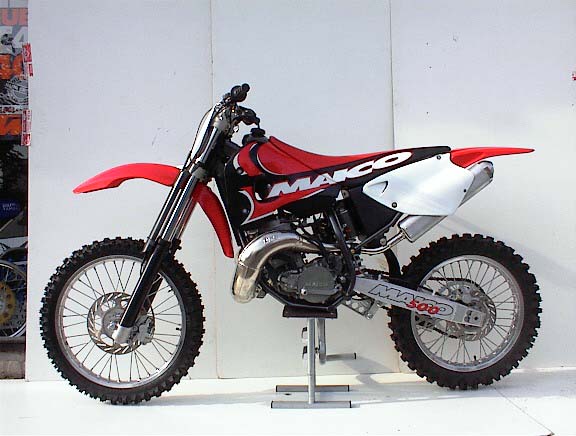Maico
history
The maico factory
was founded during the 1930's by Otto and Wilhelm Maisch. Since Wilhelm had
a background in the National socialist party during the world war II he could
only be a minority owner as stipulated by government laws in the post war period.
Wilhelms sons, Hans, Peter and Wilhelm Jr started to work for maico after their
education and regained some control over the development and business into the
hands of Wilhelm.
 During the 50's, in europe, maico had a reputation for building fast and sporty
bikes, rare and expensive but something to dream about. The bikes where two-stroke
road bikes pretty conventional in design and lightweight. They where easily
converted to off-road use. Models like 250 Blizzard, M175 and 250 MD where common.
Most of these models had the same frame base with the frame tubes forming a
loop on each side of the rear wheel. That frame design where kept until 1962.
During the 50's, in europe, maico had a reputation for building fast and sporty
bikes, rare and expensive but something to dream about. The bikes where two-stroke
road bikes pretty conventional in design and lightweight. They where easily
converted to off-road use. Models like 250 Blizzard, M175 and 250 MD where common.
Most of these models had the same frame base with the frame tubes forming a
loop on each side of the rear wheel. That frame design where kept until 1962.
In 1962 the bike
had a conventional hydraulic fork and started to look as a more modern bike.
The development continued throught the 60's and the bikes reminded a lot of
old Greeves. From the early 70's the maico bikes where famous for their look.
The square metal tank. Thick seats and modern motocross appearance with longer
suspension travel than most, yellow color and cylinders with huge cooling fins.
The swedish rider Åke Johnson was a common sight around the GP tracks.
From 1973 the engines got a familiar design and in 1974 the cylinders got their
famous radial fins so common up until 1983/84. On of the most wanted bikes for
collectors today are the 1974 model. The suspension had very long travel compared
to bikes of the past and the 400 models had power to match anything on the track.
In 1976 the suspension travel had been raised even further with rear shocks
leaning forwards. The fact is that the suspension travel race in the late 70's
was much led by maico. One can even reffer to the entire thing as the other
bikes following maico. Another maico invention was to mount the front wheel
axle in front of the lower fork leg. This allowed longer travel and a more rigid
internal structure with more overlap. This invention characerized maico forks
throughout the entire 70's and was soon to be copied by everyone else. The 77
bikes was much the same but looked different. The red color combined with modern
plastic side panes gave them a modern look. In 78-79 the bikes had the red color
scheme, modern plastic, 38mm forks and leaning shocks with long travel. The
modern engine and a rounded painted tank in metal.
So came 1980! The
1980 model was a completely redesign of practically everything except most engine
parts and some wheel components. The new plastic tank came that stayed until
1984. The brand new 42mm air assisted forks that by many are regarded as the
best as conventional forks that there is, came with a stunning 12.2 inches (310mm)
of travel. Chromolly double loop frame with a square box backbone structure.
The most significant thing though was the geometry. The bike had razor sharp
steering, neutral handling and was so easy to ride that a common joke was "riding
a maico is close to cheating". The thing is that maico got the measurements
between footpegs, handlebar and seat pretty correct. The weight distribution
was also spot on. The 440cc engine suffered by beeing one and a half horse down
by the new Yamaha YZ465 though. Unacceptable.
1981 Maico 490,
say it !, say it again, it only makes you happier. Maico had the easiest job
in he world, they had all the tools and knowhow to build the best open classer
in the world. All they had to do was to pinpoint a few details that had to be
bettered an do so. They bored out the 440cc to a full 490cc. They reconstructed
the seat tank layout to a more flat design. They changed the wheel spokes pattern.
The maico 490 from 1981 is regarded as the best open class bike ever made. The
combination of useful powerband, suspension and balance had indeed been hard
to beat. Business was good, maico earned good money. In 1981 the maico 490 sold
more open class bikes than, for example Honda did in their entire motocross
line in the US. The only bike that would outaccelerate the mighty 490 was the
awesome KTM 495.
 In 1982 maico released their first generation single shock rear suspension.
The rising rate wasn't entirely correct or to be precise much to high. The construction
also added some weight to the bike. Combining this the bike was changed for
the worse. Regardless, a correctly dialed in maico was still the fastest open
classer around the track.
In 1982 maico released their first generation single shock rear suspension.
The rising rate wasn't entirely correct or to be precise much to high. The construction
also added some weight to the bike. Combining this the bike was changed for
the worse. Regardless, a correctly dialed in maico was still the fastest open
classer around the track.
In 1983 maico released
an entirely new engine and reworked the frame and plastic too. The new engine
got rid of the chain primary drive and was extremely small. The single shock
linkage was reworked and performed much better. Maybe the 250cc engine gained
the most and was suddenly right in the pack regarding power output. The 490
was better again but hardly as good as the -81 model. I for myself had a Spider
250 and that bike was what I consider to be the best motocross bike I ever had.
Not a thing broke ever. Always a first starter and a suspension (Ohlins) that
soaked up everything, Frankly the best suspension I have ever felt. Despite
tests in magazines I tried to drag race all water cooled japanese machinery
and beat them all. It was so obvious that the maico had a better and considerably
longer powerband allowing it to pull away half a bike length or so at each gear.
The maico line started to get into trouble. The 1982 models didn't sell good
and the 1983 was an extremely important year and a kind of a second chance to
come back. Unfortunately the 1983 models faced real trouble with quality problems.
wheel hubs exploded and all kinds of things happened. Strange enough other bikes
like mine never had any problems what so ever. The market was overwhelmed by
the japanese bikes that proved to have good quality, performance and also technically
better with water-cooling, disk brakes, aluminium swingarms and good single
shock systems. The maico suffered from beeing air cooled, a steel swingarm and
not so futuristic plastic combined with old brakes. The cooling system didn't
have any impact on the power output but the buyers turned their backs on it
as outdated.
Things continued
to go wrong in 1984. the bike got water cooling but beside that not much of
importance was changed. Still the same old drum brakes and the hefty 42mm fork
so praised back in -80 wasn't a selling argument anymore since all japanese
bikes had 43mm form tubes by then. The 1985 model was changed in several ways.
Maico had decided to release a water cooled engine that was just as powerful
or even stronger than any other 250 out there. They also went back to the idea
of raising the suspension travel. It had worked so good in the past. I'm sorry
to say this but the 1985 maico 250 I had was the worst bike I ever had. It was
way too tall. A very narrow and hard seat, a high rear end making the front
too low and then this powerband. It hit hard in the midrange (I mean hard) and
signed off immidiately. I fought like a mad man trying to cut the same lap times
on the -85 as I did on my -83 but it couldn't be done. The mushy brembo disk
was much worse than the previous disk brake. The 500cc water cooled engine was
a slightly bigger success and quite a few where built as enduro machines for
the european market. It was famous for the nice and strong power output but
the open class was already dying and particular in the woods where a full sized
two stroke engine was and is too much to handle.
The 1986 machines
got a new exhaust port like the japanese bikes but it was too late to save the
business and in 1987 maico went bancrupt. The marquee has lived on in smaller
scale with smaller series and a few attempts over the years. Maybe the best
thing would be to dig up the tools and manufacture the -81 model again. Considering
the technique it should be able to sell considerably cheaper than new bikes
today and is competitive in the so popular twin shock classes and could sell
well to those wanting a bike for exercise.
 The
maico marquee today is manufactured in small scale. The customers are enthusiasts
that know what they want and is willing to go the extra mile to get one. The
machines is top modern with ø50mm forks, Reiger shocks and everything you could
expect in terms of aftermarket goodies. The open class engine from the mid 80's
lives on in sidecar motocross racing under the name Zabel and a displacement
up to 700cc. It was and still is one of the best motocross engines that ever
left the factory.
The
maico marquee today is manufactured in small scale. The customers are enthusiasts
that know what they want and is willing to go the extra mile to get one. The
machines is top modern with ø50mm forks, Reiger shocks and everything you could
expect in terms of aftermarket goodies. The open class engine from the mid 80's
lives on in sidecar motocross racing under the name Zabel and a displacement
up to 700cc. It was and still is one of the best motocross engines that ever
left the factory.
 During the 50's, in europe, maico had a reputation for building fast and sporty
bikes, rare and expensive but something to dream about. The bikes where two-stroke
road bikes pretty conventional in design and lightweight. They where easily
converted to off-road use. Models like 250 Blizzard, M175 and 250 MD where common.
Most of these models had the same frame base with the frame tubes forming a
loop on each side of the rear wheel. That frame design where kept until 1962.
During the 50's, in europe, maico had a reputation for building fast and sporty
bikes, rare and expensive but something to dream about. The bikes where two-stroke
road bikes pretty conventional in design and lightweight. They where easily
converted to off-road use. Models like 250 Blizzard, M175 and 250 MD where common.
Most of these models had the same frame base with the frame tubes forming a
loop on each side of the rear wheel. That frame design where kept until 1962. In 1982 maico released their first generation single shock rear suspension.
The rising rate wasn't entirely correct or to be precise much to high. The construction
also added some weight to the bike. Combining this the bike was changed for
the worse. Regardless, a correctly dialed in maico was still the fastest open
classer around the track.
In 1982 maico released their first generation single shock rear suspension.
The rising rate wasn't entirely correct or to be precise much to high. The construction
also added some weight to the bike. Combining this the bike was changed for
the worse. Regardless, a correctly dialed in maico was still the fastest open
classer around the track. The
maico marquee today is manufactured in small scale. The customers are enthusiasts
that know what they want and is willing to go the extra mile to get one. The
machines is top modern with ø50mm forks, Reiger shocks and everything you could
expect in terms of aftermarket goodies. The open class engine from the mid 80's
lives on in sidecar motocross racing under the name Zabel and a displacement
up to 700cc. It was and still is one of the best motocross engines that ever
left the factory.
The
maico marquee today is manufactured in small scale. The customers are enthusiasts
that know what they want and is willing to go the extra mile to get one. The
machines is top modern with ø50mm forks, Reiger shocks and everything you could
expect in terms of aftermarket goodies. The open class engine from the mid 80's
lives on in sidecar motocross racing under the name Zabel and a displacement
up to 700cc. It was and still is one of the best motocross engines that ever
left the factory.